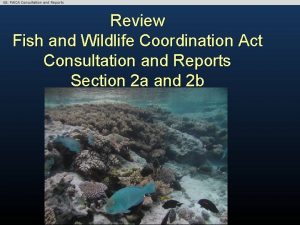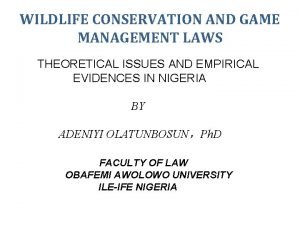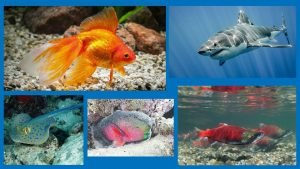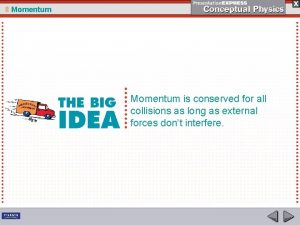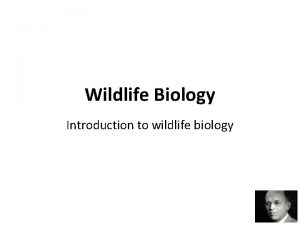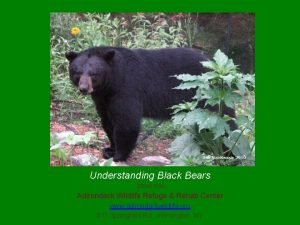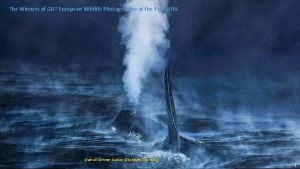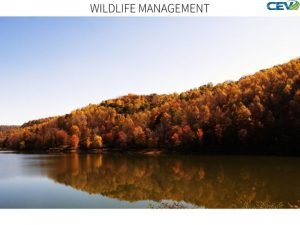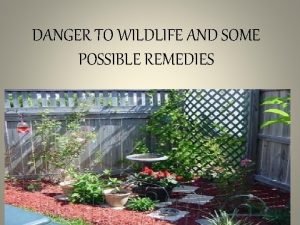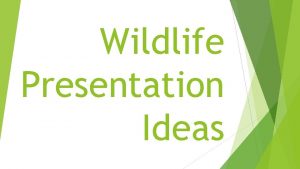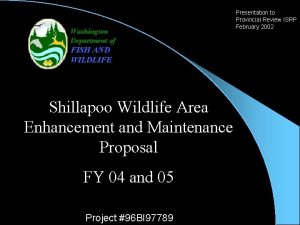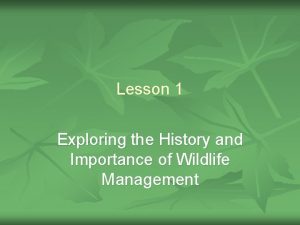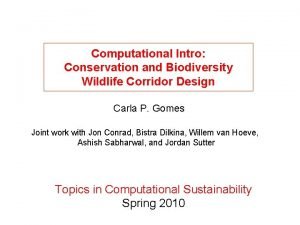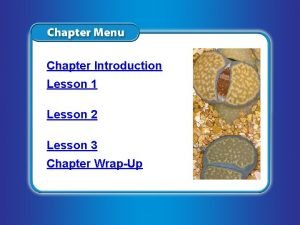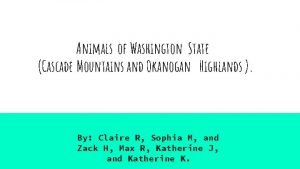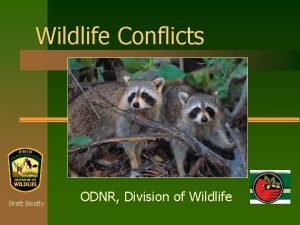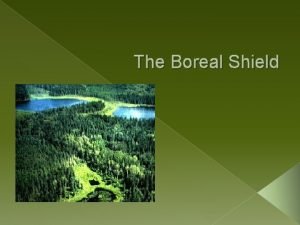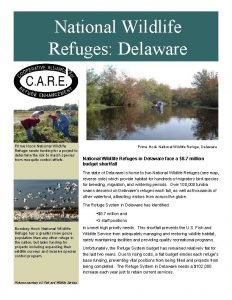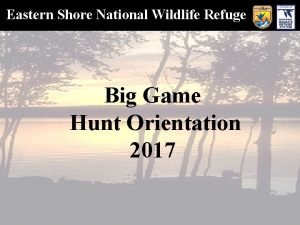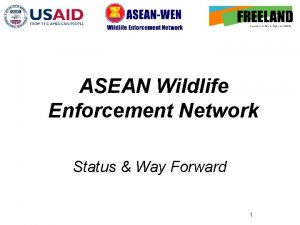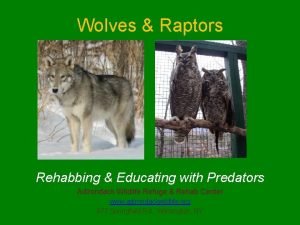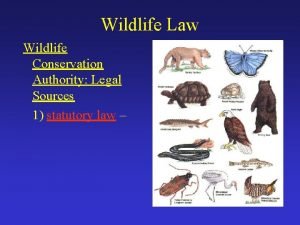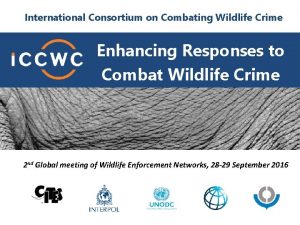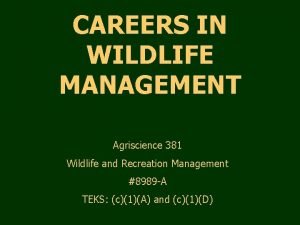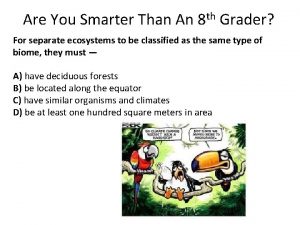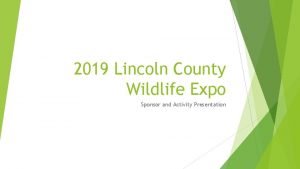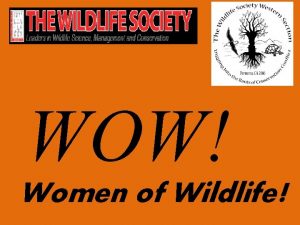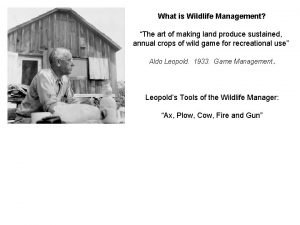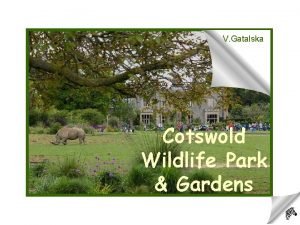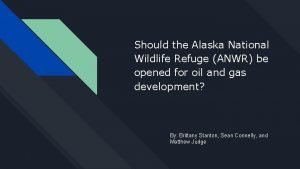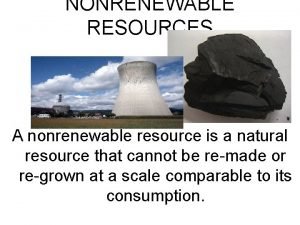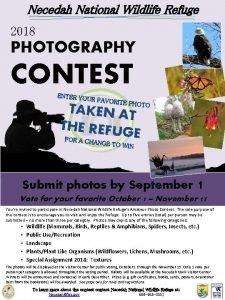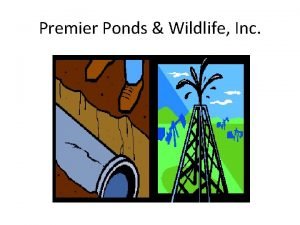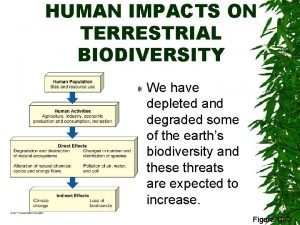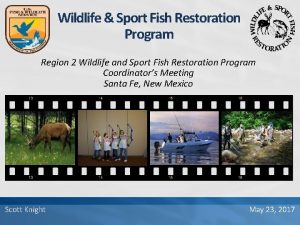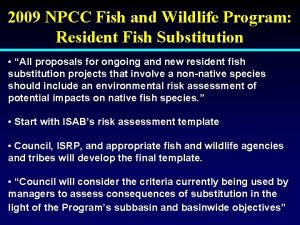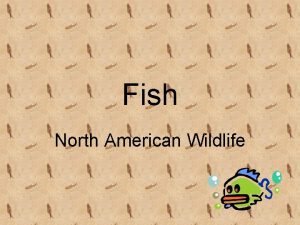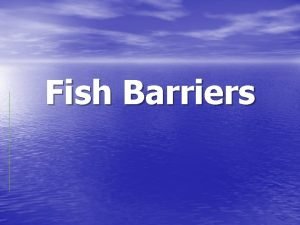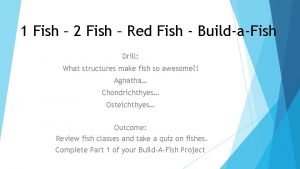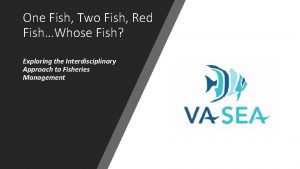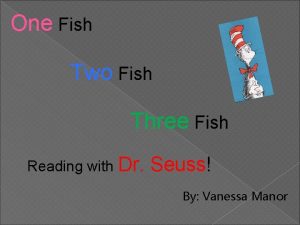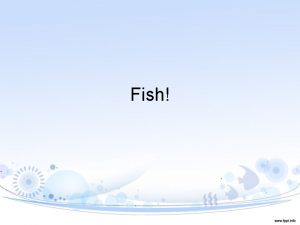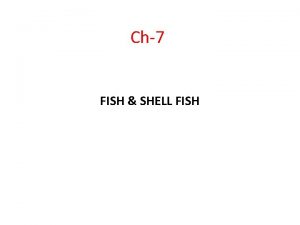U S Fish Wildlife Service Introduction to the










































- Slides: 42

U. S. Fish & Wildlife Service Introduction to the Endangered Species Act Endangered Species Program, March 2004 Slide 1

U. S. Fish & Wildlife Service Before the Endangered Species Act 1900 Lacey Act • Regulated interstate transfer of wildlife 1966 Endangered Species Preservation Act • Authorized listing of 77 species, mostly vertebrates • Authorized land acquisition 1969 Endangered Species Conservation Act • Expanded list (worldwide species and invertebrates) • Required measures to enlist international agreement 1973 CITES (Convention on International Trade in Endangered Species of Wild Fauna and Flora) • Agreement among 80 nations to ensure that trade does not threaten species survival Slide 2

U. S. Fish & Wildlife Service 1973 Endangered Species Act Allows protection for all species • Protects habitats as well as species • Gives joint authority to Fish and Wildlife Service and NOAA–Fisheries Slide 3 American alligator USFWS photo Aleutian Canada goose Desert tortoise habitat USFWS photo •

U. S. Fish & Wildlife Service The Endangered Species Act Section 2: Findings and Purposes Section 3: Definitions Section 4: Listing, Critical Habitat Designation, Recovery, Monitoring Section 5: Land Acquisition Section 6: Financial Assistance to States and Territories Section 7: The Role of Federal Agencies Section 8: International Cooperation Section 8 A: Convention Implementation Section 9: Unlawful Activities Section 10: Exceptions, including Permits Section 11: Penalties and Enforcement Slide 4

U. S. Fish & Wildlife Service Findings and Purposes Section 2 Findings • Some species of fish, wildlife and plants are now extinct “as a consequence of economic growth and development untempered by adequate concern and conservation. ” • Other species are in danger of extinction. • Species have aesthetic, ecological, educational, historical, recreational, and scientific value. Purposes “… to conserve endangered and threatened species and the ecosystems on which they depend. ” Slide 5

U. S. Fish & Wildlife Service Key Definitions Section 3 Endangered Any species in danger of extinction throughout all or a significant portion of its range Threatened Any species likely to become endangered in the foreseeable future West Indian manatee USFWS photo Oregon silverspot butterfly Photo by Jim Botoroff Critical Habitat Specific geographic areas with physical and biological features essential to the conservation of a listed species Critical habitat USFWS photo Slide 6

U. S. Fish & Wildlife Service Listing Section 4 Identifying species for possible designation as “endangered” or “threatened” • Citizen may “petition” the Fish and Wildlife Service, or • Fish and Wildlife Service may identify species through internal studies and discussion with States, academia, and other experts in the scientific community Slide 7 Petitioned for listing: the southern California mountain yellow-legged frog. Photo by Vance Vredenburg, Associated Press

U. S. Fish & Wildlife Service Candidate Species Section 4 Species that warrant listing but are precluded by higher workload priorities are placed on a candidate species list. Fish and Wildlife Service has developed programs to conserve and recover candidate species awaiting ESA protection. The northern sea otter is a candidate for listing. Corel Corp. photo Slide 8

U. S. Fish & Wildlife Service Listing Section 4 Five factors considered in determining whether a species is endangered or threatened: 1. Present or threatened destruction, modification, or curtailment of the species range or habitat 2. Over-use for commercial, recreational, scientific, or educational purposes 3. Disease or predation 4. Inadequacy of existing regulatory mechanisms 5. Other natural or man-made factors affecting the continued existence of the species Slide 9

U. S. Fish & Wildlife Service Listing Section 4 Listing Process • Use best available scientific and commercial information • Use peer-review to ensure sound science and sound decision-making • Publish Federal Register notice of a proposal to list species as endangered or threatened • Respond to public comment, and complete a final rule within one year Slide 10

U. S. Fish & Wildlife Service Listed Species by State March 2004 Endangered and threatened species are found throughout the United States. More than 1200 species of fish, wildlife, and plants are currently listed. Slide 11

U. S. Fish & Wildlife Service Critical Habitat Section 4 • Use best scientific data to identify areas essential to the conservation of a species and may require special management consideration or protection • Economic impact analysis required, and areas may be excluded from protection based on analysis • Publish Federal Register notice and seek public comment on proposal to designate critical habitat • Designation does not create a park or preserve Slide 12

U. S. Fish & Wildlife Service Recovery Section 4 Goals • Reduce or eliminate threats to listed animals and plants • Restore self-sustaining wild populations • Remove species from the list Whooping crane, a recovering species USFWS photo Slide 13

U. S. Fish & Wildlife Service Recovery Section 4 Recovery Plans Slide 14 • Develop with stakeholders • Identify recovery strategy • Identify tasks and partners • Establish delisting/downlisting criteria • Provide timetable and cost estimate • May address multiple species

U. S. Fish & Wildlife Service Recovery Section 4 Recovering listed species requires Fish and Wildlife Service and other Federal agency actions. States and private landowners are critical recovery partners. The Fish and Wildlife Service assists through grants and other incentives. The Los Angeles Zoo’s captive breeding program raises California condors for release into the Ventana Wilderness Area. Photo by Daniel Bianchetta, Ventana Wilderness Society Slide 15

U. S. Fish & Wildlife Service Delisting Section 4 • Delisting criteria identified in the species’ recovery plan • Federal Register notice published and public comment sought on proposal to delist • Recovered species monitored for five years American peregrine falcon, delisted in 1999. Corel Corp. photo Slide 16

U. S. Fish & Wildlife Service Cooperation with the States Section 6 • Recognizes States’ key role in conserving wildlife and plants • Provides funding to States with which the Fish and Wildlife Service has cooperative agreements Six states have received funding to monitor and manage reintroduced black-footed ferrets. Photo by Fort Belknap Fish and Wildlife Department Slide 17

U. S. Fish & Wildlife Service Consultations Section 7 Requires Federal agencies to: • conduct programs to conserve endangered and threatened species • ensure that actions they authorize, fund, or carry out are not likely to jeopardize the continued existence of listed species or adversely modify critical habitat If agency action may affect a listed species or critical habitat, the agency must initiate consultation with the Fish and Wildlife Service. Private individuals are affected by section 7 when their action needs a Federal permit or funding. Slide 18

U. S. Fish & Wildlife Service Consultations Section 7 Informal Consultations • Optional process to assist agencies in evaluating potential effects on species and habitat • Fish and Wildlife Service recommends modifications necessary to avoid adverse effects • If necessary modifications are made, no further consultation required The Corps of Engineers consults with the Fish and Wildlife Service about beach projects that “may affect” listed sea turtles. USFWS photo Slide 19

U. S. Fish & Wildlife Service Consultations Section 7 Formal Consultations If adverse effects are unavoidable, the Federal agency initiates formal consultation: • Relies on more detailed descriptions and other relevant studies, proposal reports, etc. • Up to 90 days of consultation, followed by 45 days to produce a “biological opinion” Slide 20

U. S. Fish & Wildlife Service Consultations Section 7 Formal consultation concludes with Fish and Wildlife Service issuing a “biological opinion” evaluating the action and providing options, where necessary. Two possible outcomes: • Federal action not likely to jeopardize species or adversely modify critical habitat • Federal action likely to jeopardize species or adversely modify critical habitat Slide 21

U. S. Fish & Wildlife Service Consultations Section 7 If action is not likely to jeopardize, biological opinion includes: • Incidental take statement estimating amount of take that may occur incidental to the action • Reasonable and prudent measures to minimize take The Fish and Wildlife Service issued a “no jeopardy” opinion to the Army regarding endangered birds at Fort Hood, Texas. USFWS photo Slide 22

U. S. Fish & Wildlife Service Consultations Section 7 If action likely to jeopardize, opinion includes reasonable and prudent alternatives that avoid jeopardy or adverse modifications and are: • consistent with intended purpose of action • within authority of Federal agency • technologically and economically feasible Compliance with reasonable and prudent alternatives allow project to continue In rare instances, such alternatives are not available Slide 23

U. S. Fish & Wildlife Service Consultations Section 7 More than 70, 000 Federal actions are reviewed annually. Of 1200 formal consultations per year, on average six percent result in a jeopardy or adverse modification finding. Slide 24

U. S. Fish & Wildlife Service Prohibited Acts Section 9 Listed plants are protected from commercial trade, collection, or malicious destruction on Federal lands, and similar actions that violate State law. Listed wildlife is protected from “take” and commercial trade. Signs posted on nest trees of endangered red-cockaded woodpeckers help prevent taking. Slide 25

U. S. Fish & Wildlife Service Prohibited Acts Section 9 Take means: harass, harm, pursue, hunt, shoot, wound, kill, trap, capture, or collect or to attempt to engage in these activities. Harm includes habitat destruction that kills or injures listed species. The take prohibition for wildlife applies to any person including a Federal agency. Section 4(d) allows flexibility of section 9 prohibitions for threatened species. Slide 26

U. S. Fish & Wildlife Service Permits Section 10 The Fish and Wildlife Service issues section 10(a)(1)(A) permits for scientific purposes or to enhance the propagation or survival of a species. A zoo may receive a permit to study or breed an endangered species such as the giant panda. San Diego Zoo photo Slide 27

U. S. Fish & Wildlife Service Private Landowner Agreements Section 10(a)(1)(A) permitting authority is used to encourage species conservation on non-Federal lands. Type of Agreement Landowner agrees to… Safe Harbor Agreement take actions to benefit listed species on their land Candidate Conservation Agreements with Assurances take actions to benefit candidate or other nonlisted species on their land Slide 28 Fish and Wildlife Service assures… no additional restrictions will be imposed as species populations improve no additional restrictions will be imposed if species is later listed

U. S. Fish & Wildlife Service Permits Section 10 The Fish and Wildlife Service issues incidental take permits to private landowners under section 10(a)(1)(B) provided an approved Habitat Conservation Plan is developed. Habitat Conservation Plans are a tool for conserving listed, proposed, and candidate species while providing for development that will not “appreciably reduce the likelihood of the survival and recovery of the species in the wild. ” Slide 29

U. S. Fish & Wildlife Service Exceptions Section 10 Experimental Populations, Section 10(j) • Experimental populations are treated as threatened • Designating an experimental population as “nonessential” provides management flexibility • Special 4(d) rules exempt some activities from section 9 prohibitions The Fish and Wildlife Service and the National Park Service reintroduced gray wolves into Yellowstone National Park as a nonessential, experimental population. USFWS photo Slide 30

U. S. Fish & Wildlife Service Penalties and Enforcement Section 11 Provides for civil or criminal penalties for ESA violations: • Civil penalties up to $25, 000 per violation • Criminal penalties up to $50, 000 and/or a year in prison per violation Provides for citizens’ lawsuits to compel the Secretary of the Interior to enforce the ESA Slide 31

U. S. Fish & Wildlife Service Tools and Incentives Candidate Conservation Through Candidate Conservation Agreements and Candidate Conservation Agreements with Assurances the Fish and Wildlife Service works with public and private parties to: • identify threats to candidate species • develop measures to conserve species • identify willing landowners and develop agreements • implement conservation measures and monitor effectiveness Slide 32 Soulen Livestock Company has entered into an agreement to conserve the southern Idaho ground squirrel on its property. USFWS photo

U. S. Fish & Wildlife Service Tools and Incentives State Conservation Agreements State-led initiative to conserve declining species before they need protection under the ESA • Supported by the Fish and Wildlife Service and other Federal agencies • The publication of the International Association of Fish and Wildlife Agencies Slide 33

U. S. Fish & Wildlife Service Tools and Incentives Candidate Species “The candidate list is an important tool, helping to identify imperiled species and focusing attention on the need to conserve them before they receive Endangered Species Act protection. By working to recover these species now, in partnership with States, local communities and individuals, we can implement flexible, cost-effective conservation measures that put them on the road to recovery. ” USFWS Director Steve Williams USFWS photo Slide 34

U. S. Fish & Wildlife Service Tools and Incentives Safe Harbor Agreements Voluntary agreements for recovering listed species • Open to states, businesses, individuals—any non-Federal landowner • Encourages landowners to improve conditions for listed species on their land by removing fear of subsequent restrictions on land use • Can create long-term benefits for species extending beyond period of agreement Slide 35

U. S. Fish & Wildlife Service Tools and Incentives Conservation Bank Agreements A Conservation Bank is a voluntary agreement with a landowner that provides an economically effective process to offset adverse impacts to listed species. • Wilson Valley Mitigation Bank, Riverside County, California, managed by the Center for Natural Lands Management Slide 36 • • Habitat for listed species is treated as a benefit rather than a liability. Simplifies regulatory compliance process. Reduces ‘piecemeal’ approach to conservation efforts.

U. S. Fish & Wildlife Service Tools and Incentives Cooperation with the States Grants • Traditional Conservation Grants to States • Habitat Conservation Plan Land Acquisition • Habitat Conservation Planning Assistance • Recovery Land Acquisition The endangered Hawaiian monk seal will benefit from added habitat through a section 6 recovery land acquisition grant. Smithsonian Institution photo Slide 37

U. S. Fish & Wildlife Service Tools and Incentives Additional Service Grants • Private Stewardship Grants • Landowner Incentive Program • State Wildlife Grants • Tribal Grants More than half of all listed species have 80 percent of their habitat on non-Federal land. USFWS photo Slide 38

U. S. Fish & Wildlife Service Guiding Principles Initiate conservation measures early to preclude the need to list species. • Peer-review is essential in ensuring the use of sound science in decision-making, listing species, designating critical habitat, and developing recovery plans. • Partnerships — with States, other Federal agencies, local communities, non-governmental organizations, and individuals — are the key to success in conserving and protecting species for the benefit of all. • Slide 39

U. S. Fish & Wildlife Service Guiding Principles The Four Cs Consultation, Cooperation, and Communication — all in the service of Conservation Department of the Interior Secretary Gale Norton. DOI photo Slide 40

U. S. Fish & Wildlife Service Fish and Wildlife Service Regional Offices The endangered species program is on the web at endangered. fws. gov Slide 41

Endangered Species Program, March 2004
 One fish two fish red fish blue fish ride
One fish two fish red fish blue fish ride Twofish and blowfish
Twofish and blowfish Scale types fish
Scale types fish Fish and wildlife coordination act
Fish and wildlife coordination act Introduction of wildlife conservation
Introduction of wildlife conservation Is croaker a cartilaginous fish
Is croaker a cartilaginous fish Cartilaginous fish vs bony fish
Cartilaginous fish vs bony fish A big fish swims up and swallows a small fish at rest
A big fish swims up and swallows a small fish at rest What are the market forms of shellfish
What are the market forms of shellfish Manipulative management wildlife
Manipulative management wildlife Adirondack black bears
Adirondack black bears Gdt european wildlife photographer of the year
Gdt european wildlife photographer of the year Objectives of wildlife management
Objectives of wildlife management Hebbalasu
Hebbalasu Animal depletion
Animal depletion Wildlife topics for presentation
Wildlife topics for presentation Basic requirements of wildlife
Basic requirements of wildlife Shillapoo wildlife area
Shillapoo wildlife area History of wildlife conservation
History of wildlife conservation Wildlife corridor design
Wildlife corridor design Wildlife reproduction
Wildlife reproduction Cascade mountains wildlife
Cascade mountains wildlife Odnr division of wildlife
Odnr division of wildlife Boreal shield wildlife
Boreal shield wildlife Spoil wildlife
Spoil wildlife Prime hook national wildlife refuge map
Prime hook national wildlife refuge map Eastern shore wildlife refuge hunting
Eastern shore wildlife refuge hunting Asean wildlife enforcement network
Asean wildlife enforcement network Adirondack wildlife refuge
Adirondack wildlife refuge Wildlife conservation law
Wildlife conservation law Wildlife adalah
Wildlife adalah Diane boyd wildlife biologist act
Diane boyd wildlife biologist act Careers in wildlife management
Careers in wildlife management Wildlife biologist
Wildlife biologist Fielders pro shop brookhaven ms
Fielders pro shop brookhaven ms Wildlife protection force wow
Wildlife protection force wow Wildlife management as an art
Wildlife management as an art Cotswold wildlife park
Cotswold wildlife park Arctic national wildlife refuge oil drilling pros and cons
Arctic national wildlife refuge oil drilling pros and cons Wildlife protection act
Wildlife protection act Necedah wildlife refuge map
Necedah wildlife refuge map Wildlife pond ladder
Wildlife pond ladder Impacts of wildlife trade on terrestrial biodiversity
Impacts of wildlife trade on terrestrial biodiversity



